Every brand has its pluses and minuses, but in the case of Ford, I love the feel of the sporty Fiesta. It's been 10 years since I had the sixth generation Fiesta S, with "only" 100 rabid horsepower from a 1.6 naturally aspirated, and I remember driving it like it was yesterday. And I didn't have a better time with that car because I only had two years of experience and stability control wasn't standard or optional. The Fiesta ST at the time had the same problem.
The Fiesta ST is a type of car that you enjoy much more when you have experience, because you have a better sense of how far you can push the limits. This car will allow us to go very far, a novice driver won't know how to stop and can make the aids intervene. However, an experienced driver will know how to take it to the limit, not to exceed it, touch it, and go a little further (or so Senna said). We are facing a considerably pistonudo model.
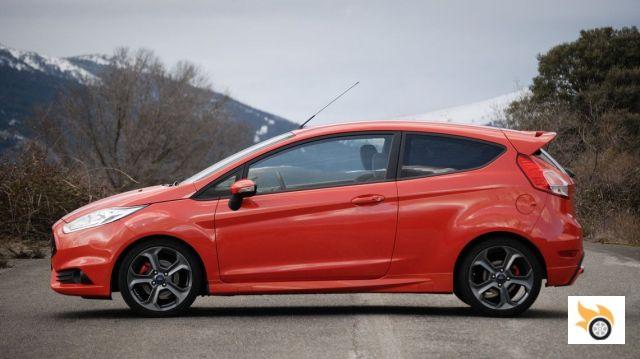
Design
There are brands where you can confuse a sporty model with another that is disguised as such, but this is not the case with the Fiesta ST. Its aesthetic kit is exclusive, and if we try to fit it on a Fiesta TDCi the pieces are not going to fit; this was done with all the intention in the world. The Ford Fiesta ST looks sporty and it is. However, even if it could be imitated, it would still have a distinctive detail: it's the only Fiesta with disc brakes on the rear axle, all the others use drums. The daytime running lights are integrated into the headlights.
It's exclusive enough, considering the Fiesta is the best-selling car in Europe.
The styling kit consists of a front fascia with tent-like grille and honeycomb structure, ST logos, dedicated fog lights, unique five-spoke wheels with 205/40 R17 tyres, red-painted brake calipers, side skirts, tinted windows, rear aero diffuser, dual exhaust tailpipes and rear spoiler. No badge says "Fiesta", just "ST". One of the things I appreciate about the design of this car is that it's not overly cluttered, although I've never really been convinced by the massive seventh-generation headlamps.
The range of five colors available includes exclusive shades for it: Race Red, Molten Orange (like the tested unit) and Spirit Blue. There is another version from this year, called Fiesta ST200, which has exclusive Storm Grey paint and the wheels share the same design, but in matte black, plus the "ST200" logo. Otherwise, they are the same. It's marketed exclusively as a three-door, although in countries like the US it's available with five doors, and it's 40kg more.
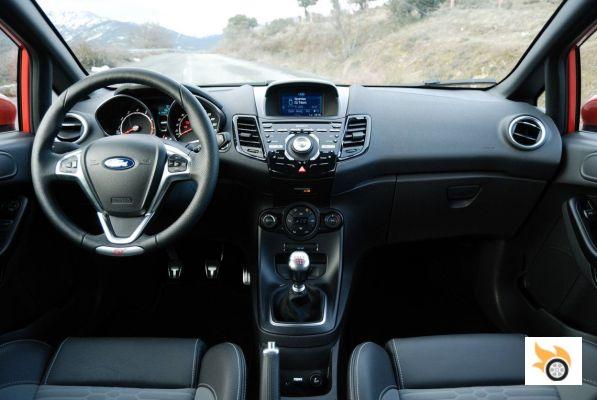
Cabin
For better and for worse, it's a Ford Fiesta, although it has a few details that set it apart from the others. For starters, it has Recaro heated front seats in grey or red, which maximise cornering for those of us with a normal build. Someone bulkier won't feel very comfortable in them. Considering the lateral accelerations that this car can transmit, its approach is right: the important thing is to carry the body well supported. Those in the back better hold on when it comes to the curves.
The driver will notice a different steering wheel, with the ST badge at the bottom, and aluminium pedals. One of the obvious advantages of the seventh-generation Fiesta ST over its predecessor is that the left foot is much better seated on the floor, because it has a proper footrest. You'll find "carbon fibre-like" inserts - that's what Ford calls them, although they look like piano black - which are very discreet. They could have used the same colour as the upholstery, for example. It is appreciated that some surfaces are padded, it is a plus of quality.
It is a bit outdated in terms of design, as it derives from a model that appeared in 2008. Although it already underwent a mid-life update in 2012, the screen has become too small, it's not tactile, and the top button panel has become as crowded as the Millennium Falcon. In fact, it's highly likely the car will go to the scrap heap without the driver ever touching a button. French rivals, the Clio RS and 208 GTi, are clearly ahead in this respect, but they're also more modern.
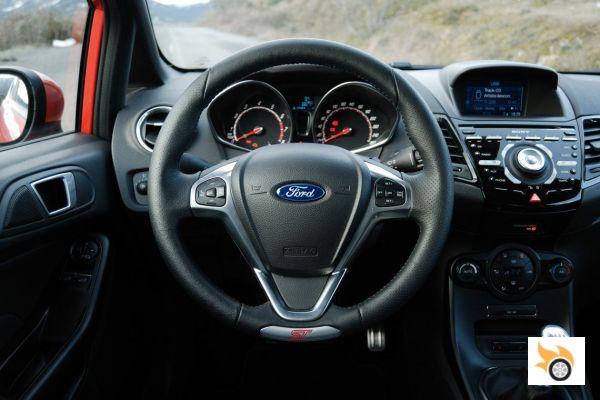
Other details that show the Fiesta's age are the monochrome displays for the on-board computer and the single-zone climate control. To compensate for the shortcomings of the analogue instrumentation (speedometer, tachometer and fuel gauge) the digital display shows the coolant temperature. Missing are readings for turbo boost pressure, oil pressure and oil temperature. In fact, the computer doesn't even have an instantaneous economy meter, although it does display average fuel consumption and range, as well as average speed.
A distinctive feature of the Fiesta ST is the "Sound Symposer", which enhances low-frequency engine sounds and brings them into the cabin in a natural way. It's not an artificial sound system through the car's speakers, but a membrane, and it's a better solution than cars five times the price. The exhaust line isn't particularly loud, but this way the driver can feel the engine better without the whole neighbourhood doing it.
Otherwise, it is a fully equipped Fiesta, in fact it has no optional items, everything comes standard.
On a long trip some very sensitive passengers may find the noise annoying when the engine is loaded or driving fast, as it enhances the natural sound. In my opinion, if you know what you are buying, thinking about driving it, you will not feel annoyed. What's more, you can perceive sounds from the turbo that make the experience more pleasant. It has a turbo engine, and you can tell it's a turbo. For my taste, the wastegate should be more outrageous, but at least you can tell it's there.
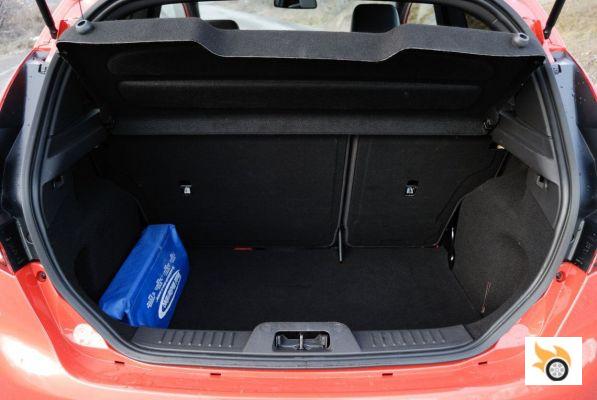
Like a three-door Fiesta, the roominess isn't brilliant, four adults are a bit cramped, especially if driver or passenger are a bit tall. Access and egress to and from the rear seats isn't brilliant either, although the doors are large, but there has to be room to open them. The three doors are not so practical, of course, but in terms of design it is what suits a car that is advertised as sporty.
It doesn't shine when it comes to storage space. Between the two front seats, there are two drink wells, one of which is unusable if you use the cup ashtray. There's also a small elbow-lid storage box, which has a hole to pass cables through without catching them when it's closed. The USB and 12-volt power socket is completely in view. In front of the gearbox there is a very small hole that is not very useful, due to its size and the ease with which small objects -such as coins- can slip out of it.
Finally we have the trunk. Naturally, there's nothing special about it compared to any other Fiesta. The top tray is only attached to the tailgate on one side, so you don't have to put anything on top of it if you don't want it to bend. There are two hooks for hanging small bags, useful for small items. Under the floor we will not find useful load capacity. It has 290 litres of capacity with puncture repair kit, or 276 litres with temporary spare wheel (or biscuit).
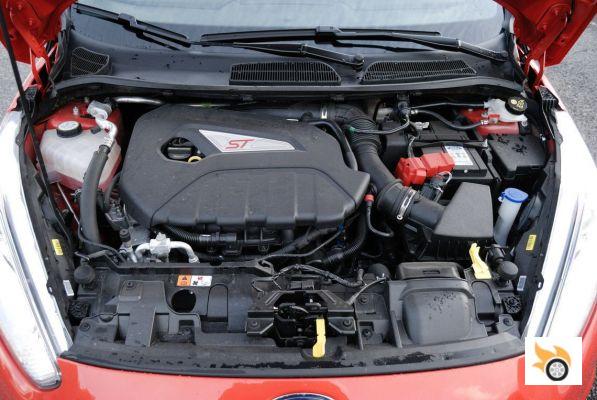
Technical
It's not the first Fiesta sports car with a turbo engine, remember the third generation RS Turbo from 1989. It took 20 years after it went off the market for a turbine to return to a Fiesta's canyon. The 1.6 EcoBoost delivers 182 hp, a figure that rises to 200 hp in the case of the Fiesta ST200. The maximum torque is limited to 240 Nm, although for 20 seconds it delivers 290 Nm due to the "Overboost" function, thus shortening the distance needed to overtake. Well, more than overtaking, it overflies.
This is a direct petrol injection engine with variable valve lift control. When driven in a civilised manner it is capable of very reasonable fuel consumption, even competitive with a 1.0 EcoBoost in the hands of an average driver. When stepped on it's not overly guzzly, so it's in a healthy middle ground. Achieving an average of 5.9 l/100 km, as it homologates, seems impossible to me without Volkswagen cheating in some way.
The car's tuning is in line with its performance.
The Ford Team RS engineers have achieved an excellent result, it's a sports car, but it's not a torture rack. The centre of gravity is lowered by 15 mm compared to the normal Fiesta, the same happens with the ST200. Shock absorbers and springs are stiffer, and the front axle has been altered. The rear torsion bar has been stiffened to reduce roll. Weighing 1,163 kg has not resorted to an excessively hard suspension, but it is noted that it is bouncy and wants to stick the car constantly to the ground. The urban jumps must be taken with affection.
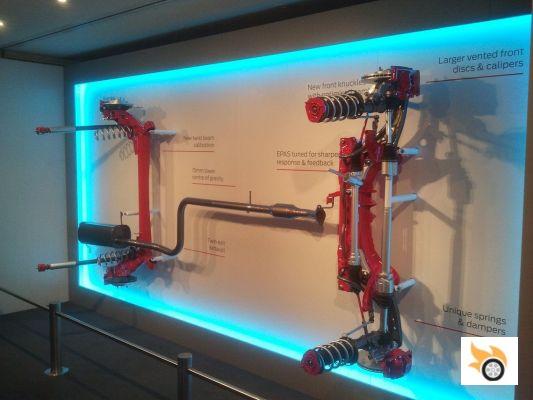
In the all-important braking section, it has 278×23 millimetre ventilated discs at the front and 253×10 mm solid discs on the rear axle. The Fiesta ST is the first derivative of its platform that does not use rear drum brakes. To provide more braking power, the brake servo master cylinder is larger. It doesn't have mechanical lock-up, but the front brakes simulate it; Ford calls it eTVC or Enhanced Torque Vectoring Control. In the language of Cervantes, the wheel with the least traction is braked so that the torque is shifted to the opposite wheel. This solution saves weight.
As for the stability control (ESP) it has three modes
In the default mode the car prevents us from losing control, and a skilled driver will be able to make a spirited driving without constant intervention. In other words, a good driver will be able to keep it active without being disturbed. For those who want to go faster, there is a relaxed mode in which the intervention comes later, and you can do more mischief with the rear axle and light drifts. Finally there is the "bare mode", in which only the ABS and the aforementioned eTVC work.
It also has adjustments to the electromechanical power steering. The rack and pinion is shorter, so you have to make 2.32 turns of the steering wheel between stops. The arm is shorter and provides a more realistic feel, the driver will be able to be aware of what is happening under the wheels at all times. There are no different degrees of assistance and the steering wheel can be adjusted in both height and depth.
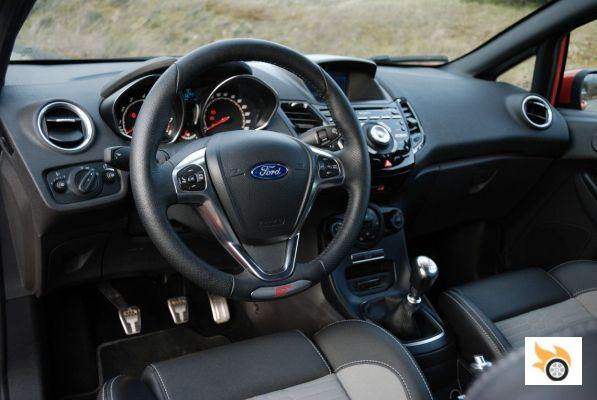
Driving
With the Ford Fiesta we can unleash our bipolar traits. It can be an everyday Fiesta, with very reasonable fuel consumption and the same comforts available on the Fiesta Titanium. With the upgraded features, it also has better active safety. In the most extreme case, in the event of an accident, the car will alert the emergency services as long as the mobile phone is associated by BlueTooth (and if we have not done so, it gives a warning shortly after starting).
On the other hand, the Fiesta ST can be a car with which we remove the license in two or three "pilladas" of the fat ones. In the French presentation I was stopped by the gendarmerie, testing this a camouflaged Guardia Civil, and I came out unscathed both times. I honestly don't know what happens to me with Fords, but the chance of being stopped is much higher than with cars of any other brand. I actually started my ticket history with a Streetka. If I had a different haircut I'd probably get pulled over every time I was seen.
It's a car with a sweet tooth and it attracts attention.
You have to have a high dose of self-control to drive this car, because it subliminally invites us to do the animal with constant character. On more than one occasion, during the test, I got my wires crossed a bit. After testing cars for 12 years, I was supposed to be a little bit more nervous, but I wasn't. And it has plenty of power to make you feel like a real animal. And it's got plenty of power to take its freak-out to penal proportions: it does 220 km/h (137 mph).
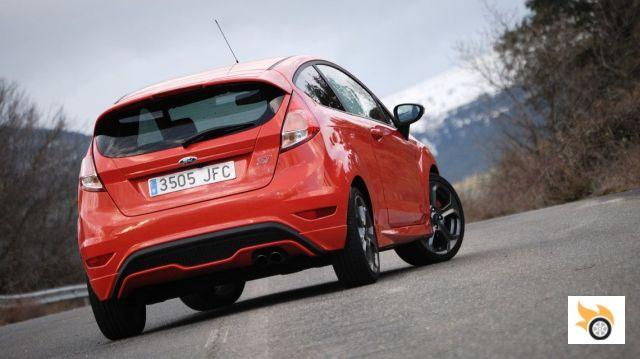
But it's not just how fast it runs, it's how it recovers. There's a legend going around that some press cars are packed tighter than usual to make us journalists more impressed. I'd bet the keys to the Supra that this test unit is "touched". From 80 to 120 km/h I stopped the stopwatch in 5 and a bit seconds, both in third and fourth gear. Those times remind me of cars like the BMW 130i (E87) with six cylinders and 265 hp, it's amazing for a small car!
If you compare the data sheets of the Fiesta ST with other sports cars, it is one of the least powerful, but the performance figures are very even. For anyone who thinks 182bhp is low, there's the ST200 with 200 "round", but I wouldn't be surprised if this car gave 200bhp or more on a dyno. Whoever finds this unit for sale, don't even think about it, it runs like hell.
This car is very well tuned, light, and has plenty of power. The technical data speaks of 0-100 km / h in 6.9 seconds and 50-100 km / h in 6.4 seconds in fourth gear, is more than good. You can really appreciate how much it pushes when accelerating in any gear, it doesn't have excessively long ratios, even in sixth gear it still has nerve and you don't need to downshift frequently. And when driving over the legal limits it is clear that it has the lung for that and more.
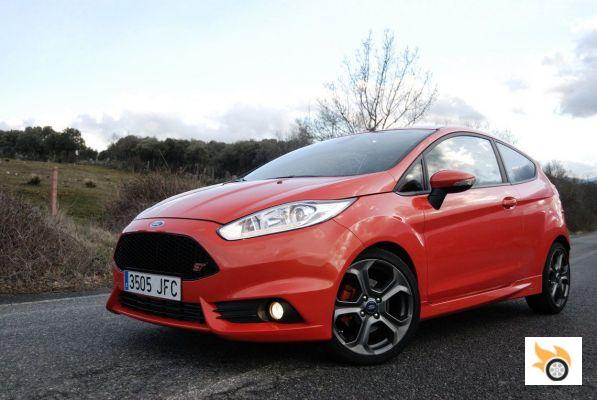
Let's leave the straights and move on to the bends. The Fiesta ST allows us to enter the same curve faster than with many cars, it always seems to hold a little more. Well positioned, the supports can be devilish, and when we want to change sides is very agile, without just lying down, is to hook curves one after the other and enter into a frenzy that brings us closer to emulate a racing driver (at which point it begins to be minimally dangerous).
The gear knob is also made of aluminium. The gears enter quickly and well
It doesn't have a clear tendency to understeer, when it does, it's the four wheels and we're already overdriven. The typical understeer of the front axle is easy to correct with a light touch on the brake. Having an electronic differential, we will not notice that the steering wheel goes into the curve when we accelerate past the apex, unlike models like the Juke RS, with mechanical self-locking. The braking performance is excellent because of how well the brakes hold and how well they are dosed, allowing surgeon-like precision.
Partially disabling the ESP, the rear axle is more playful, but in good hands is something fun and without additional risks. The Bridgestone Potencia tyres hold the Fiesta ST perfectly, allowing a fast and precise driving, in which the driver can feel the road as if he was caressing it. If you can have a great time on the straights, I'm not talking about the corners. My usual mountain pass was very short, it made me want to go down it and repeat, and more than once, but I would have got too hot.
In circuit I have not driven it, but colleagues speak well of it in this habitat.
Those who have ridden it with me and have taken it for a "ride" agree that the sensations are very intense, and all this while maintaining absolute control of the car. I'd love to know how fast you can go through a city centre -assuming there's no traffic at all, with traffic cut-offs- and go as fast as possible around roundabouts. It seems an ideal choice to escape from the police after having given a "stick". I want to make it clear that I don't want to make an apology for any criminal act, it's a literary license.
If you like driving a lot, and want a small car, but a killer, don't take your eye off the Fiesta ST. I'm curious to see how much the difference with the Fiesta ST200 is noticeable, if it's already disgustingly fun with 182 hp. The engine certainly doesn't show any signs of exhaustion, it's like inviting Dwayne Johnson ("The rock") to join us at the gym, he might not even sweat. The comparison with the 1989 RS Turbo is absurd, that car was nowhere to take it, here the chassis is up to the power of the engine.
Is there anything I can say against it? No, not even for fuel consumption. According to the computer the fuel consumption was 7.8 l/100 km, but my calculations point to 7.2-7.3 l/100 km having had a lot of fun with it, and with an average speed of 66 km / h, higher than usual. It's perfectly possible to go under 7 l/100 km in 100% DGT compliant mode. It doesn't have a brilliant range due to the 42 litres of fuel in the tank, but doing 500 km until the reserve jumps is a good figure.
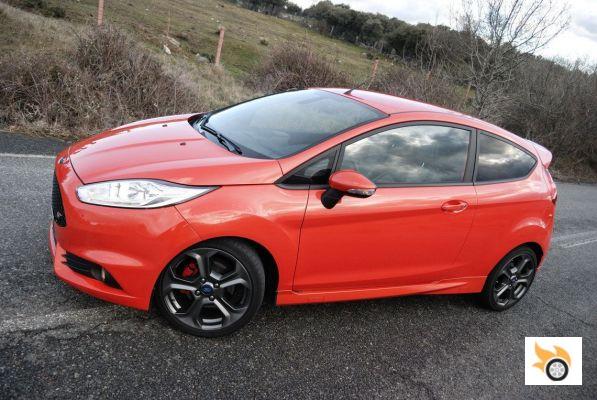
Conclusions
One of the most fun and efficient front-wheel drive cars I've ever tested. The combination of powerful engine, sporty tuning and very low weight never disappoints. You don't need a bigger or more powerful car to enjoy it like a kid, although at certain times it would be better if it was a rear-wheel drive (something absurd in a two-volume subcompact). Once again, an excellent job by Ford's engineers. They have worked hard, in the press kit they boast of having tested it on the Nardo circuit in 40 degrees, and thousands of kilometers of high-speed circuit tests.
It's not up to date on certain things, it's true. Its Ford SYNC system is first generation, when in the US they're about to release SYNC 3. Anyway, what's the point? It pairs your mobile phone, lets you listen to music via Bluetooth Audio and reads discs. A bigger screen can be a source of distraction, although things like the Clio RS's reshulon telemetry or more digital gauges are missed. Test driving this car will bring you dangerously close to wanting one, or ditching your usual transport appliance. I've given it some serious thought, I admit.
Faced with rivals that impose five doors, or an automatic gearbox, or artificial engine sound, the Fiesta ST is a back to the basics, or in other words, what a sports car should be: no colouring or preservatives. What you see on the outside is a statement of intent and is a true reflection of what goes underneath. You can use it every day, and occasionally put it on circuits to go to calzone removed, and with a very reasonable price: 22,825 euros recommended retail price, which can be less than 20,000 taking advantage of the most favorable offer. It's not very cheap either, the Hyundai i30 Turbo costs practically the same.
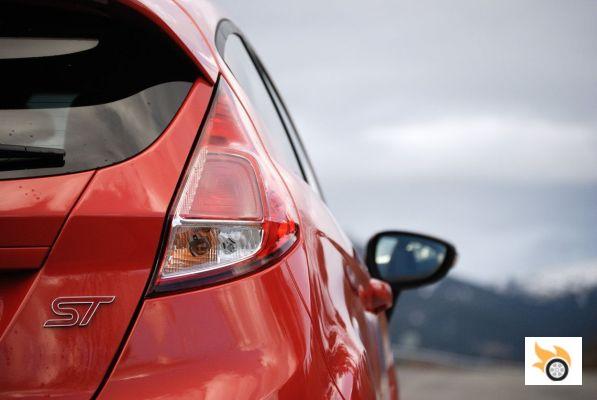
If you're a few years old and you're thinking of sharing this car with your offspring at some point, there's a wonderful thing - not for them - called MyKey. It's possible to limit the top speed, prevent the stability control from switching off, limit the "volts" of the stereo or make it psychologically impossible to drive without a seatbelt. All you have to do is program a third key.
I don't think it's a dangerous car for a novice driver if he doesn't try to tickle it. The stability control in its default mode intervenes in time and form, but as always, the limits of physics cannot be crossed. Where an expert driver can save the situation, a novice can screw up even with ESP. What's more, I think it's generally advisable to take a sports driving course to get the most out of this car, but with a good head.
If we forget about "secondary" things like the habitability, the size of the touch screen, the on-board applications and all that, it seems to me to be one of the most recommendable in its category. The Clio RS didn't convince me, the 208 GTi was a bit underwhelming (although there's a better version that I haven't tried, but Guille has), and other rivals I haven't driven enough.
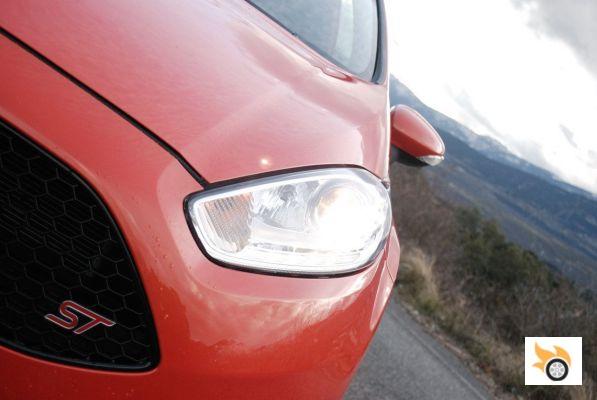
My personal choice would be very clear: I'd take this one, or the ST200 if I had the money and could afford a good insurance with legal defense, I was going to need it someday. Actually, the ST200 has a little more power (up to 215 hp temporarily), shorter gears to benefit the acceleration and tweaks to the suspension, the rest are aesthetic details or is the same. We'll have to test it to see if that difference is worth it in terms of money. Ah, the ST200 is a limited edition, this is not. Don't miss out on yours, or you'll regret it over the years.

























